Below you can find a list of subjects for bachelor and master internships, contact information can be found in the descriptions or contact us via CONTACT.
Internships
-
IDentifying the culprit in Systemic Scleroderma
More informationClinical relevance
Systemic scleroderma (SSc) is a chronic autoimmune disease that is characterized by immune dysregulation, vascular abnormalities and extensive fibrosis of the skin and internal organs.
In severe cases, SSc can rapidly lead to organ failure and death. Unfortunately, the etiology of SSc is only poorly understood, greatly hampering the development of a treatment. Therefore, there is great need for a better understanding of what drives the excessive fibrosis in this devastating disease.
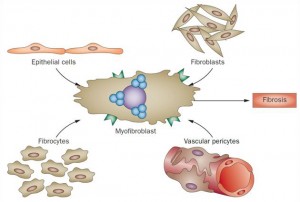
-
High cholesterol levels and osteoarthritis: the role of PCSK9 cholesterol homeostasis and the promotion of synovial inflammation.
More informationClinical Relevance
Osteoarthritis (OA) is the most common disabling disease worldwide, characterized by joint pain and immobility. OA affects the whole joint, including articular cartilage, synovium, subchondral bone and ligaments. Synovial inflammation is present in approximately 50% of OA patients and aggravates cartilage degradation and ectopic bone formation in the joint. Currently, no curative treatment options are available. Patients receive symptomatic treatment and eventually joint replacement.
-
Transforming the future of SSc patients by targeting excessive TGFβ signaling
More informationClinical Relevance
Systemic sclerosis or scleroderma (SSc) is a rare but severe systemic autoimmune disease. Scleroderma, literally “hard skin” is characterized by vasculopathy and excessive fibrosis of skin, hardening it to the point that any flexibility is lost and movement of affected areas becomes difficult. Many patients also develop progressive fibrosis in their visceral organs, leading to e.g. kidney and respiratory failure. In severe cases, SSc can rapidly (< 3 years) lead to organ failure and death. Unfortunately, the etiology of SSc is only poorly understood, greatly hampering the development of a treatment. Therefore, there is great need for a better understanding of what drives the excessive fibrosis in this devastating disease.

-
Unraveling the function of exosomes in rheumatoid arthritis patients and studying their biological effects.
More informationClinical Relevance
Previously exosomes were considered to be cellular waste products but nowadays it is known that they play a key role in intercellular communication [1]. They have been identified in a number of biological fluids such as blood, saliva, urine and breast milk [2] and are also detected in synovial fluid and plasma obtained from rheumatoid arthritis (RA) patients [3]. RA patients are treated with many different therapies, however it is still unknown whether a patient will react positively to the therapy of choice beforehand. Developing a non-invasive assay based on the detection of exosomal content (eg. miRNAs, proteins, etc.), which will predict the effect of specific treatments in RA-patients would be of great benefit.
-
Photodynamic therapy to treat rheumatoid arthritis
More informationClinical Relevance
Rheumatoid Arthritis (RA) is a systemic autoimmune disease that affects up to 1% of the population worldwide. The RA pathology is characterized by chronic inflammation of the joints, leading to progressive physical disability and pain. Although the development and use of various biologicals targeting specific pathways has improved prognosis for some RA patients, approximately 30% of patients still fail to respond adequately. Therefore, the search for new therapeutic targets in RA treatment needs to continue.
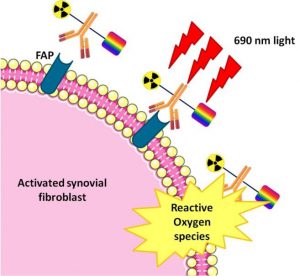
-
Innately wrong; aberrant function of innate immune suppressor cells as driver of systemic sclerosis
More informationClinical Relevance
Systemic sclerosis (SSc) is a severe auto-immune disease characterized by excessive fibrosis of skin and internal organs. This fibrosis disrupts organ function, resulting in a high morbidity, increased mortality and a profound loss of quality of life for patients. Currently, no cure is available, resulting in a high unmet medical need.
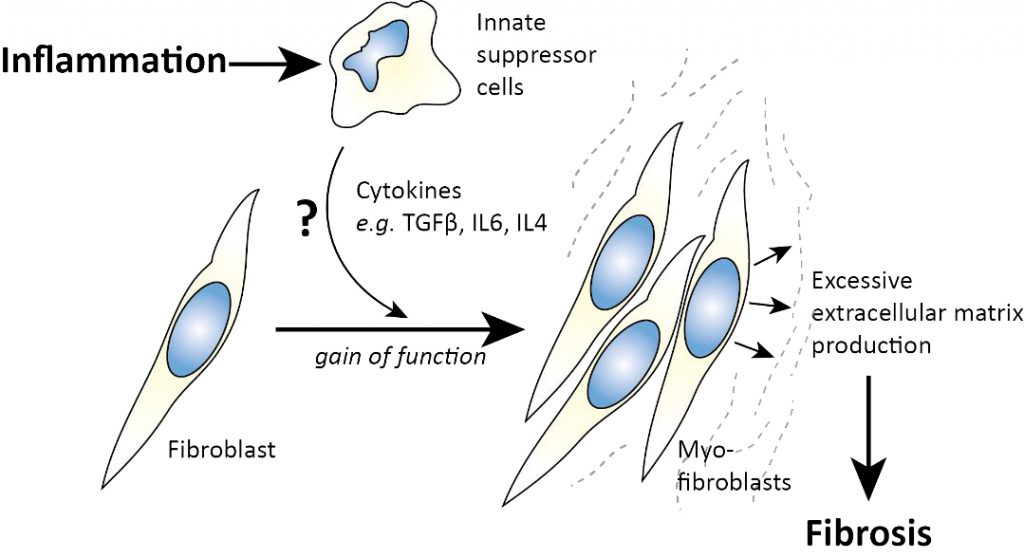
-
How does the alarmin S100A8/A9 steer differentiation and activation of innate immune cells?
More informationClinical Relevance
Rheumatoid arthritis (RA) and osteoarthritis (OA) are two inflammatory arthritic diseases that affect millions of people worldwide. Both diseases are characterized by destruction of the joint, which includes breakdown of the articular cartilage, altered turnover/breakdown of the bone and inflammation in the synovium (the tissue that lines the joint cavity). Patients suffer from severe pain and an impaired mobility of the affected joints. However, the underlying molecular mechanisms remain largely elusive, which urges more research into the mechanisms that cause these complaints.
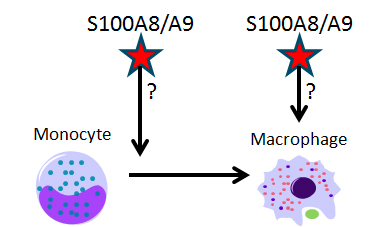
-
Alarmins S100A8/9 as targets for pain treatment in Osteoarthritis (OA). How to kill the alarm?
More informationClinical Relevance
Osteoarthritis (OA) is the most common degenerative and disabling joint disease that affects millions of people worldwide. Its main morphological characteristics are breakdown of the articular cartilage, new-bone formation and prominent changes in the synovium. However, for the patient the main problem is pain. Pain is the most important cause of the disability in OA. So far, no sufficient, long lasting, therapeutic strategy is available to alleviate pain in OA-patients.

-
Metabolic syndrome and OA: the role of PCSK9 in regulating LDL levels and the promotion of inflammation in OA.
More informationClinical Relevance
Osteoarthritis (OA) is the most common disabling disease worldwide, characterized by joint pain and immobility. OA affects the whole joint, including articular cartilage, synovium, subchondral bone and ligaments. Synovial inflammation is present in approximately 50% of OA patients and aggravates cartilage degradation and ectopic bone formation in the joint. Currently, no curative treatment options are available. Patients receive symptomatic treatment and eventually joint replacement.
-
How do the alarmins S100A8 and S100A9 affect differentiation and activation of innate immune cells?
More informationClinical Relevance
Rheumatoid arthritis (RA) and osteoarthritis (OA) are two inflammatory arthritic diseases that affect millions of people worldwide. Both diseases are characterized by destruction of the joint, which includes breakdown of the articular cartilage, altered turnover/breakdown of the bone and inflammation in the synovium (the tissue that lines the joint cavity). Patients suffer from severe pain and an impaired mobility of the affected joints. However, the underlying molecular mechanisms remain largely elusive, which urges more research into the mechanisms that cause these complaints.
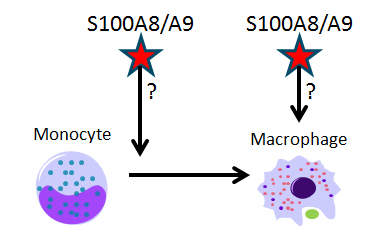
-
Pain in rheumatoid arthritis: interplay between the nervous system and inflammation via TLR4
More informationClinical Relevance
Rheumatoid Arthrits (RA) and Osteoarthritis (OA) are diseases in which pain is a major issue. Even though the main cause of the disease is inflammation or destruction, the major symptom driving patients towards the clinic is pain. It is still unclear what causes this pain in RA and OA, which is why we want to unravel the mechanism behind this pain.
-
Validation of novel small molecule inhibitors against S100A8/A9
More informationClinical Relevance
Osteoarthritis (OA) is a joint disease that affects millions of people worldwide. Patients suffer from swollen joints, stiffness and pain. The disease is characterized by breakdown of the cartilage and inflammation in a lot of patients. Current treatment consists of pain medication, corticosteroids to reduce the inflammation and eventually joint replacement surgery.
Successful Internships
-
Een ervaring om te delen: Stage van Justin, Eva, Daniëlle en Lisa
Als eerstejaarsstudentes Biomedische Wetenschappen hadden wij het voorrecht om tijdens het laatste blok van het jaar, BMW OMB02, twee weken lang stage te mogen lopen bij de Afdeling Experimentele Reumatologie van het Radboudumc. We werden begeleid door Esmeralda Blaney Davidson, Arjan van Caam en Laurie de Kroon, drie ontzettend enthousiaste onderzoekers die heel veel tijd en energie in ons onderzoek hebben gestoken. Hiervoor natuurlijk veel dank! Ons onderzoek was gefocust op de inductie van Smad7 expressie door TGFβ in kraakbeen. Tot onze verrassing bevatte ons deel van het onderzoek over TGFβ een tot op heden nog niet eerder onderzocht aspect. Wij konden als eerstejaars BMW’ers dus al echt iets gaan betekenen!
We mochten elke dag meekijken, meedenken en meedoen, waardoor we een goede indruk kregen van het leven van een onderzoeker. Wat ons opviel was de prettige, relaxte werksfeer, die mede tot stand kwam door de enthousiaste collega’s. Maar dit is slechts een van de weinige indrukken die we daar hebben opgedaan. Omdat we zoveel mochten ervaren is het eigenlijk onbegonnen zaak om aan een opsomming te beginnen. Toch kunnen we wel met 100% zekerheid tegen iedereen zeggen dat ons enthousiasme voor het onderzoek doen flink is toegenomen na de stage bij Experimentele Reumatologie!

V.l.n.r.: Justine Eerden, Eva van der Pasch, Daniëlle Wevers, Lisa van Hoogstraten
-
Een ervaring om te delen: Stage van Maren, Femke en Jessica
Voor onze studie Biomedische Wetenschappen hebben we aan het eind van het eerste jaar een stage gelopen van twee weken. Wij hebben deze zelf geregeld en gekozen voor de afdeling Experimentele Reumatologie van het Radboud UMC . De pathobiologie had onze voorkeur omdat we graag wilden ervaren hoe het is om in een lab te werken. We hebben een goede indruk gekregen van het hele onderzoeksproces zoals literatuuronderzoek, de huid van koeienpoten eraf halen, RNA isolatie en verwerken van resultaten tot een presentatie en een abstract.
Ons onderzoek was gericht op de vraag of BMP’s uit de kraakbeencel vrijkomen na schade en of deze actief zijn. Hierin werden we goed geholpen door enthousiaste en betrokken begeleiders. Hiervoor willen we Esmeralda Blaney Davidson, Arjan van Caam, Guus van den Akker, Laurie de Kroon en Ellen van Geffen bedanken. Het leuke aan ons onderzoek was dat het nog niet eerder was uitgevoerd en dat we meehielpen bij het opdoen van nieuwe kennis. We hebben de kans gekregen om heel veel zelf te doen binnen een gezellige sfeer. De onderzoekers op de afdeling stonden open voor een gesprek waardoor we een goed beeld hebben gekregen van het werkveld. Deze twee interessante weken hebben ons erg enthousiast gemaakt voor een toekomstige loopbaan in de wetenschap. Dus als je op zoek bent naar een stage waarbij je nieuwe kennis opdoet, veel leert over een baan in de wetenschap en een erg leuke tijd wil hebben, is deze afdeling een grote aanrader!
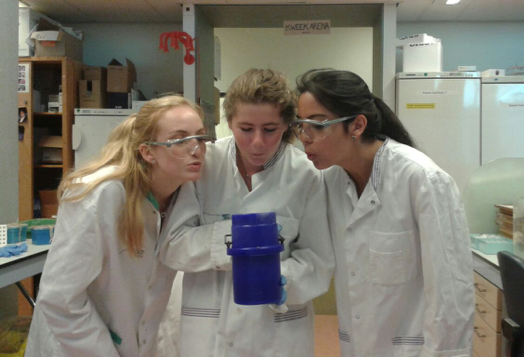
V.l.n.r.: Maren Bormann, Femke ter Braak en Jessica Aguilar Diaz
-
Een ervaring om te delen: Stage van Juan Antonio
I am Juan Antonio Fafian Labora, PhD Student of University of A Coruña in Cellular Therapy and regenerative medicine group. I got an EMBO Fellowship Short to visit the Experimental Rheumatology department in Fons Van de Loo´s group from 24th September 2015 to 24th December 2015 and I had a great reception. My project is entitled, “Effect of ageing on the pro-inflammatory potential of MSC-derived exosomes”. I think that it was a good opportunity in my scientific career because in this group I could tackle different questions of my topic and with their help got a lot more out of my project. With hard work they taught me that exosomes aren´t science fiction and I learned also about gene therapy in rheumatoid arthritis. We got very promising results and the abstract that I wrote about this was accepted for presentation at the congress of International Society Extracellular Vesicles (ISEV) 2016. I would like to return to Nijmegen and continue my collaboration with Fons Van de Loo´s group.
